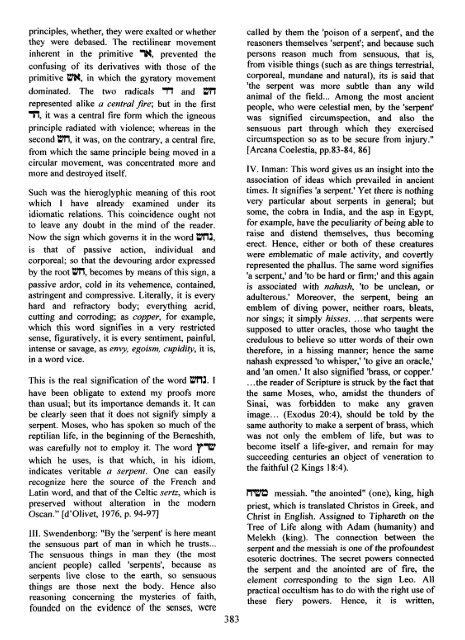Gematria - Sepher Sapphires Volume 1.pdf
Gematria - Sepher Sapphires Volume 1.pdf
Gematria - Sepher Sapphires Volume 1.pdf
Create successful ePaper yourself
Turn your PDF publications into a flip-book with our unique Google optimized e-Paper software.
principles, whether, they were exalted or whether<br />
they were debased. The rectilinear movement<br />
inherent in the primitive %, prevented the<br />
confusing of its derivatives with those of the<br />
primitive WN, in which the gyratory movement<br />
dominated. The two radicals 'PT and<br />
represented alike a central3re; but in the first<br />
T, it was a central fire form which the igneous<br />
principle radiated with violence; whereas in the<br />
second tWI, it was, on the contrary, a central fire,<br />
from which the same principle being moved in a<br />
circular movement, was concentrated more and<br />
more and destroyed itself.<br />
Such was the hieroglyphic meaning of this root<br />
which I have already examined under its<br />
idiomatic relations. This coincidence ought not<br />
to leave any doubt in the mind of the reader.<br />
Now the sign which governs it in the word Iflfif,<br />
is that of passive action, individual and<br />
corporeal; so that the devouring ardor expressed<br />
by the root m, becomes by means of this sign, a<br />
passive ardor, cold in its vehemence, contained,<br />
astringent and compressive. Literally, it is every<br />
hard and refractory body; everything acrid,<br />
cutting and corroding; as copper, for example,<br />
which this word signifies in a very restricted<br />
sense, figuratively, it is every sentiment, painful,<br />
intense or savage, as envy, egoism, cupidity, it is,<br />
in a word vice.<br />
This is the real signification of the word Iflfi3. I<br />
have been obligate to extend my proofs more<br />
than usual; but its importance demands it. It can<br />
be clearly seen that it does not signify simply a<br />
serpent. Moses, who has spoken so much of the<br />
reptilian life, in the beginning of the Beraeshith,<br />
was carefully not to employ it. The word Yw<br />
which he uses, is that which, in his idiom,<br />
indicates veritable a serpent. One can easily<br />
recognize here the source of the French and<br />
Latin word, and that of the Celtic sertz, which is<br />
preserved without alteration in the modern<br />
Oscan." [d'olivet, 1976, p. 94-97]<br />
111. Swendenborg: "By the 'serpent' is here meant<br />
the sensuous part of man in which he trusts ...<br />
The sensuous things in man they (the most<br />
ancient people) called 'serpents', because as<br />
serpents live close to the earth, so sensuous<br />
things are those next the body. Hence also<br />
reasoning concerning the mysteries of faith,<br />
founded on the evidence of the senses, were<br />
called by them the 'poison of a serpent', and the<br />
reasoners themselves 'serpent'; and because such<br />
persons reason much from sensuous, that is,<br />
from visible things (such as are things terrestrial,<br />
corporeal, mundane and natural), its is said that<br />
'the serpent was more subtle than any wild<br />
animal of the field ... Among the most ancient<br />
people, who were celestial men, by the 'serpent'<br />
was signified circumspection, and also the<br />
sensuous part through which they exercised<br />
circumspection so as to be secure from injury."<br />
[Arcana Coelestia, pp.83-84, 861<br />
IV. Inman: This word gives us an insight into the<br />
association of ideas which prevailed in ancient<br />
times. It signifies 'a serpent.' Yet there is nothing<br />
very particular about serpents in general; but<br />
some, the cobra in India, and the asp in Egypt,<br />
for example, have the peculiarity of being able to<br />
raise and distend themselves, thus becoming<br />
erect. Hence, either or both of these creatures<br />
were emblematic of male activity, and covertly<br />
represented the phallus. The same word signifies<br />
'a serpent,' and 'to be hard or firm;' and this again<br />
is associated with nahash, 'to be unclean, or<br />
adulterous.' Moreover, the serpent, being an<br />
emblem of diving power, neither roars, bleats,<br />
nor sings; it simply hisses. . . .that serpents were<br />
supposed to utter oracles, those who taught the<br />
credulous to believe so utter words of their own<br />
therefore, in a hissing manner; hence the same<br />
nahash expressed 'to whisper,' 'to give an oracle,'<br />
and 'an omen.' It also signified 'brass, or copper.'<br />
... the reader of Scripture is struck by the fact that<br />
the same Moses, who, amidst the thunders of<br />
Sinai, was forbidden to make any graven<br />
image ... (Exodus 20:4), should be told by the<br />
same authority to make a serpent of brass, which<br />
was not only the emblem of life, but was to<br />
become itself a life-giver, and remain for may<br />
succeeding centuries an object of veneration to<br />
the faithful (2 Kings 18:4).<br />
messiah. "the anointed" (one), king, high<br />
priest, which is translated Christos in Greek, and<br />
Christ in English. Assigned to Tiphareth on the<br />
Tree of Life along with Adam (humanity) and<br />
Melekh (king). The connection between the<br />
serpent and the messiah is one of the profoundest<br />
esoteric doctrines. The secret powers connected<br />
the serpent and the anointed are of fire, the<br />
element corresponding to the sign Leo. All<br />
practical occultism has to do with the right use of<br />
these fiery powers. Hence, it is written,


